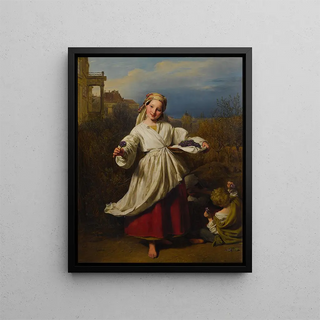Art print | The Flower Seller - Ferdinand Georg Waldmüller


View from behind

Frame (optional)
In the shimmering universe of 19th-century art, "The Flower Seller" by Ferdinand Georg Waldmüller stands out for its ability to capture the very essence of everyday life. This artwork, imbued with realism and emotion, transports us to a fleeting moment where the beauty of flowers blends with the innocence of exchanges between the artisan and his clients. Waldmüller, master of portraiture and still life, manages to breathe soul into his subjects, making every detail lively and vibrant. The piece, both simple and complex, invites us to attentive contemplation, where each color and gesture tells a story.
Style and uniqueness of the work
Waldmüller's style is characterized by meticulous realism, particular attention to detail, and a vibrant color palette. In "The Flower Seller," delicate nuances of the petals contrast with the rough texture of the seller's clothing, creating a captivating visual dialogue. The interplay of light and shadow reveals the depth of forms, while the skillfully orchestrated composition guides the viewer's eye through the scene. The artist succeeds in establishing an emotional connection between the subject and the viewer, making the work almost tactile. This ability to transcend the simple painting to evoke feelings of nostalgia and ephemeral beauty makes Waldmüller a true pioneer of his time.
The artist and his influence
Ferdinand Georg Waldmüller, born in 1793 in Vienna, is often regarded as one of the forerunners of the realist movement in art. His academic training, combined with a unique sensitivity to daily life, allowed him to create works that resonate with rare authenticity. Influenced by the romantic currents of his era, Waldmüller was able to incorporate elements of nature and urban life into his compositions, thus offering a faithful reflection of Viennese society in the 19th century. His influence extends beyond his time, inspiring many artists to explore everyday life as a source of inspiration. With "The Flower Seller," he reminds us that beauty often hides in the simplest moments, a lesson

Matte finish

View from behind

Frame (optional)
In the shimmering universe of 19th-century art, "The Flower Seller" by Ferdinand Georg Waldmüller stands out for its ability to capture the very essence of everyday life. This artwork, imbued with realism and emotion, transports us to a fleeting moment where the beauty of flowers blends with the innocence of exchanges between the artisan and his clients. Waldmüller, master of portraiture and still life, manages to breathe soul into his subjects, making every detail lively and vibrant. The piece, both simple and complex, invites us to attentive contemplation, where each color and gesture tells a story.
Style and uniqueness of the work
Waldmüller's style is characterized by meticulous realism, particular attention to detail, and a vibrant color palette. In "The Flower Seller," delicate nuances of the petals contrast with the rough texture of the seller's clothing, creating a captivating visual dialogue. The interplay of light and shadow reveals the depth of forms, while the skillfully orchestrated composition guides the viewer's eye through the scene. The artist succeeds in establishing an emotional connection between the subject and the viewer, making the work almost tactile. This ability to transcend the simple painting to evoke feelings of nostalgia and ephemeral beauty makes Waldmüller a true pioneer of his time.
The artist and his influence
Ferdinand Georg Waldmüller, born in 1793 in Vienna, is often regarded as one of the forerunners of the realist movement in art. His academic training, combined with a unique sensitivity to daily life, allowed him to create works that resonate with rare authenticity. Influenced by the romantic currents of his era, Waldmüller was able to incorporate elements of nature and urban life into his compositions, thus offering a faithful reflection of Viennese society in the 19th century. His influence extends beyond his time, inspiring many artists to explore everyday life as a source of inspiration. With "The Flower Seller," he reminds us that beauty often hides in the simplest moments, a lesson






